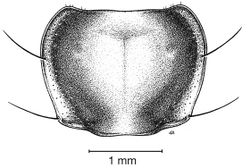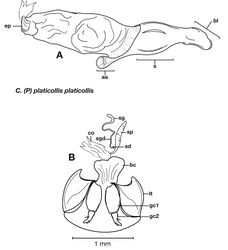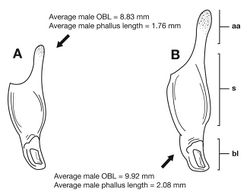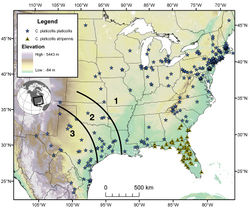Cymindis platicollis platicollis
| Notice: | This page is derived from the original publication listed below, whose author(s) should always be credited. Further contributors may edit and improve the content of this page and, consequently, need to be credited as well (see page history). Any assessment of factual correctness requires a careful review of the original article as well as of subsequent contributions.
If you are uncertain whether your planned contribution is correct or not, we suggest that you use the associated discussion page instead of editing the page directly. This page should be cited as follows (rationale):
Citation formats to copy and paste
BibTeX: @article{Hunting2013ZooKeys259, RIS/ Endnote: TY - JOUR Wikipedia/ Citizendium: <ref name="Hunting2013ZooKeys259">{{Citation See also the citation download page at the journal. |
Ordo: Coleoptera
Familia: Carabidae
Genus: Cymindis
Name
Cymindis platicollis (Say) stat. n. – Wikispecies link – Pensoft Profile
- Lebia platicollis Say 1823[1]: 14. NEOTYPE male; TYPE LOCALITY – Allegheny, Allegheny County, Pennsylvania, U.S.A. ; designated by Lindroth and Freitag 1969[2]: 350.
- Cymindis platicollis; LeConte 1848[3]: 189.
- Cymindis fuscata Dejean 1831[4]: 321. HOLOTYPE (probably), male in Chaudoir/Oberthür collection, labeled: “Latreille” [handwritten– green paper] [MNHP] – LeConte 1848[3]: 189.
- Pinacodera fuscata; Schaum 1857[5]: 294. – Chaudoir 1875[6]: 3. – Horn 1882[7]: 162. – Leng 1915[8]: 588. – Casey 1920[9]: 280. – Notman 1928[10]: 240. – Lindroth 1955[11]: 24. – 1969[12]: 1068. – Kirk 1969[13]: 16. – 1970[14]: 17.
- Pinacodera platycollis; Schaum 1857[5]: 294 (unjustified emendation) – Brimley 1938[15]:125.
- Pinacodera platicollis; Chaudoir 1875[6]: 2. – Horn 1882[7]: 147. – Blatchley 1910[16]: 152, 153. – Notman, 1928: 239. – Lindroth, 1969: 1068–1069. – Lindroth and Freitag 1969[2]: 350. – Kirk 1969[13]: 16. – 1970[14]: 17. – Ciegler 2000[17]: 119.
- Pinacodera punctigera (Dejean 1831[4]) Wickham 1897[18]: 112 [not LeConte 1851[19]: 178].
- Cymindis planipennis; Casey 1913[20]: 189 [not LeConte 1863[21]: 6].
- Pinacodera abbreviata Casey 1920[9]: 283. HOLOTYPE male labeled: “Col”.; “Casey bequest 1925”; “TYPE USNM 47614” [ red paper], “abbreviata Csy” [handwritten] [USNM]. TYPE AREA – Colorado, U.S.A. syn. n.
- Pinacodera obscura Casey 1920[9]: 284. Female, labeled: “Southern Pines, A H Manee”, N.C.; “Casey bequest, 1975”; “TYPE USNM 47612” [red paper]; “obscura Csy” [handwritten] [USNM]. – Brimley 1938[15]: 125. – Fattig 1949[22]: 40. syn. n.
- Pinacodera ampliata Casey 1920[9]: 282. [= Pinacodera planipennis Casey 1913[20]].
Holotype
female, labeled: “Col”; “Casey bequest 1925”; “TYPE USNM 47611” [red paper]; “ampliata Csy” [handwritten] [USNM].
Diagnosis
Specimens of this subspecies have uniformly colored head, pronotum, and elytra, with translucently bordered pronotum and elytra (Fig. 12).
Description
With character states of subgenus Pinacodera and species Cymindis platicollis restricted as follows: OBL. 8.17 – 11.67 mm. Length (n= 20 males, 20 females): head 0.80 – 1.08, pronotum 1.56 – 2.36, elytra 4.92 – 6.83, metepisternum 1.10 – 1.70 mm; width: head 1.60 – 2.28, pronotum 2.00 – 3.32, elytra 3.33 – 5.17, metepisternum 0.60 – 0.84 mm.
Body proportions. HW/HL 1.83 – 2.26; PWM/PL 1.16 – 1.41; EL/EW 1.29- 1.49; ML/MW 1.71 – 2.07.
Color. Dorsal surface of head brown to rufo-piceous; pronotum and elytra brunneo-piceous to rufo-piceous, with pale, somewhat translucent margins. Antennae and palpi rufo-testaceous to brunneous palpi; elytral epipleura testaceous to rufo-testaceous; ventral thoracic sclerites and abdominal sterna testaceous to piceous.
Microsculpture. Microlines not visible on dorsum of head capsule and pronotum at 50× magnification. Elytra with mesh pattern isodiametric, microlines clearly defined throughout dorsal surface.
Macrosculpture and pilosity. Head capsule dorsally with fine, randomly scattered setigerous punctures (setae not visible or only barely so at 50× magnification) from constriction of neck extended anteriorly toward clypeus. Elytra with striae moderately impressed and punctulate throughout length; intervals slightly convex (few with greater convexity in intervals 1, 3 and 5); abdominal sterna with fine pilose punctures throughout.
Fixed setae. Elytra with 14–15 lateral (umbilical) setae;two setae on each of abdominal sterna III to VI; 4 setae along apical margin of sternum VII (Fig. 3).
Luster. Head capsule and pronotum glossyl elytra moderately glossy.
Pronotum. Anterior transverse impression shallow (Fig. 13); posterior transverse impression moderately deep; median longitudinal impression moderately shallow; posteriolateral angles almost right angled to obtuse.
Hind wings. Macropterous.
Male genitalia. Phallus (Fig. 14A) length 1.70 – 2.42 mm.
Variation
Through the range of Cymindis platicollis platicollis a three-phased cline is observed (Fig. 17, Table 4). Phase 1: northeastern specimens have an average overall body length of 8.83 mm, average phallus length of 1.76 mm (Fig. 15A) and are dorsally glabrous; (~75%) with a single row of ~50–80 (interval 2 with more than 70) punctures in interval 1–7, some (~25%) with one to two rows of punctures in intervals 2, 4 and 6, all others with one row of punctures (except interval 8 with two to four rows). Phase 2: more southern specimens have an average overall body length of 9.22 mm, average phallus length 1.82 mm and have dorsal setation on humeral area of elytra; some specimens with few setae visible on dorsum of head and disc of elytra; (~86 %) with odd intervals bearing one row of scattered setigerous puncture and even intervals bearing two or three rows of scattered setigerous punctures, others (~14%) with interval 2 having two or three rows of setigerous punctures (rarely one row), interval 8 with two or three rows, and all other intervals bearing one row of setigerous punctures. Phase 3: southwestern specimens (extreme south west Oklahoma to mid-western Texas south west to Nuevo Leon) have an average overall body length of 9.92 mm, an average phallus length of 2.08 mm (Fig. 15B) and are dorsally setose, most individuals having one or two rows (mostly two) of moderately deep, randomly spaced, pilose punctures in all intervals, interval 8 with two to three rows. Few with various combinations of above.
| Locality | N | Punctation states / No. individuals | ||
|---|---|---|---|---|
| 1 | 2 | 3 | ||
| Nebraska | 6 | 6 | 0 | 0 |
| Iowa | 8 | 8 | 0 | 0 |
| Kansas | 2 | 1 | 1 | 0 |
| Arkansas | 2 | 2 | 0 | 0 |
| Mississippi | 31 | 31 | 0 | 0 |
| Louisiana | 16 | 13 | 3 | 0 |
| Oklahoma | 66 | 1 | 61 | 4 |
| East Texas | 45 | 10 | 35 | 0 |
| Mid Texas | 74 | 1 | 21 | 52 |
| West texas | 16 | 4 | 0 | 12 |
| New Mexico | 1 | 0 | 0 | 1 |
| Nuevo Leon | 3 | 0 | 0 | 3 |
| Totals | 270 | 77 | 121 | 72 |
Habitat, habits and seasonal occurrence
The known elevational range of Cymindis platicollis platicollis extends from 3 to 1935 m. Specimens were collected under stones, under and on bark of trees and associated mosses in forests of buckeye, beech-magnolia, elm, hackberry, hickory, juniper, mesquite, oak, oak-pine, and tamarack. It has been collected from shrub species Leucaena pulver (Schltdl.), from bromeliads associated with oak and also from the nest of woodrats, Neotoma micropus Baird. Adults are crepuscular, and most commonly collected from late February through July.
I witnessed several pairs in copula over a three-week period of collecting in Georgia and Florida from late February to mid-March of 2008. Of these mated pairs I brought 9 females and 10 males back to the University of Alberta to attempt rearing larvae. I kept them all in a single plastic container with substrate from under the trees they were captured on. A wet ball of tissue provided moisture, and several 3rd to 5th instar larvae of cabbage looper moth species Trichoplusia ni (Hübner) were introduced each week for food. All individuals (with the exception of one female) survived for the first three months in captivity. By mid-June (three months after capture) males started to die, and within the next two weeks all had expired. All of the remaining eight females lived at least until mid-September (6 months after capture) with the last individual dying in early November (7.5 months after capture). Males lived an average of 82 days after capture and females lived more than twice as long with an average lifespan of 166.5 days after capture.
All beetles were removed from the container every week and the substrate was searched for eggs and larvae. No evidence of oviposition was found. Other attempts to rear larvae from mated Pinacodera adults (Mahar, 1978) were also unsuccessful. Many lebiines are known to have unusual ovipositional habits or needs; that may also be the case in Pinacodera and a reason why rearing is problematic.
Collecting methods include asafetida and molasses traps, sugar baits painted on tree trunks, beating and sweeping vegetation, at light and u.v. light, Lindgren funnel traps, Berlese traps, Malaise traps, flight intercept traps (FIT’s), pitfall traps, hand collecting, and sticky traps.
Geographical distribution
The range of this subspecies (Fig. 17) extends in eastern Canada from southern Quebec west to southern Ontario; in the eastern United States from Maine south to mid-Georgia west to eastern Colorado and Nebraska south to southern Texas. In Mexico it is known from Nuevo Leon in the northern portion of the Sierra Madre Oriental.
Evolutionary affinities
This subspecies is, by definition the closest relative of Cymindis platicollis atripennis.
Chorological affinities
Cymindis platicollis platicollis is sympatric in portions of its range with Cymindis limbata, Cymindis complanata, Cymindis punctigera punctigera, and Cymindis chevrolati. It is allopatric with Cymindis platicollis atripennis, Cymindis rufostigma, and all other taxa in the limbata species group.
Material examined
I have examined 897 specimens of Cymindis platicollis platicollis: 24 males and 17 females were dissected. For details see University of Alberta Strickland Virtual Entomology Museum Database (University of Alberta 2009[23]).
Taxon Treatment
- Hunting, W; 2013: A taxonomic revision of the Cymindis (Pinacodera) limbata species group (Coleoptera, Carabidae, Lebiini), including description of a new species from Florida, U.S.A. ZooKeys, 259: 1-73. doi
Other References
- ↑ Say T (1823) Descriptions of insects of the families Carabici and Hydrocanthari of Latreille, inhabiting North America. Transactions of the American Philosophical Society (2)2: 1–109.
- ↑ 2.0 2.1 Lindroth C, Freitag R (1969) North American ground-beetles (Coleoptera, Carabidae, excluding Cicindelinae) described by Thomas Say: designation of lectotypes and neotypes. Psyche 76: 326-361.
- ↑ 3.0 3.1 LeConte J (1848) A descriptive catalogue of the geodephagous Coleoptera inhabiting the United States east of the Rocky Mountains. Annals of the Lyceum of Natural History of New York 4: 173-474. doi: 10.1111/j.1749-6632.1848.tb00277.x
- ↑ 4.0 4.1 Dejean P (1831) Spécies general des coléoptères de la collection de M. le comte Dejean, vol. 5, Paris, 883.
- ↑ 5.0 5.1 Schaum H (1856–1860) (1857). Naturgesichte der Insecten Deutschlands. Erste Abtheilung. Coleoptera Erste Band. Nicolaische Verlagsbuchhandlung, Berlin, 791 pp.
- ↑ 6.0 6.1 Chaudoir M (1875) Genres aberrants du groupe des cymindides. Bulletin de la Société Impériale des Naturalistes de Moscou vol. 49, pt. 2, pp. 1–61
- ↑ 7.0 7.1 Horn G (1882) Synopsis of the species of the tribe Lebiini. Tranactions of the American Entomological Society 10: 126–164, illus.
- ↑ Leng C (1915) List of the Carabidae of Florida. Bulletin of the Amerian Museum of Natural History 34: 555-601.
- ↑ 9.0 9.1 9.2 9.3 Casey T (1920) Random studies among the American Caraboidea. In: Casey TL, Memoirs on the Coleoptera, Vol IX. New Era Publishing Company, Lancaster, Pennsylvania, 133–299.
- ↑ Notman H (1928) Carabidae. In: Leonard MD (Ed) The Insects of New York (Cornell University, Ithaca New York, 207–252.
- ↑ Lindroth C (1955) The carabid beetles of Newfoundland including the French islands St. Pierre and Miquelon. Opuscula Entomologica Supplementum 11: 1-160.
- ↑ Lindroth C (1969) The ground beetles (Carabidae excl. Cicindelinae) of Canada and Alaska. Part 6. Opuscula Entomologica, Supplementum 35: 945-1192.
- ↑ 13.0 13.1 Kirk V (1969) A list of the beetles of South Carolina Part 1- northern coastal plain. South Carolina Agricultural Experiment Station Technical Bulletin 1033: 124-148.
- ↑ 14.0 14.1 Kirk V (1970) A list of the beetles of South Carolina. Part 2—mountain, piedmont, and southern coastal plain. South Carolina Agricultural Experiment Station Technical Bulletin 1038: 1-117.
- ↑ 15.0 15.1 Brimley C (1938) The insects of North Carolina. North Carolina Department of Agriculture, Division of Entomology, Raleigh.
- ↑ Blatchley W (1910) The Coleoptera or beetles of Indiana. Bulletin of the Indiana Department of Geology and Natural Resources No. 1, 1–1386, illus.
- ↑ Ciegler J (2000) Ground beetles and wrinkled bark beetles of South Carolina (Coleoptera: Geadephaga: Carabidae and Rhysodidae). South Carolina Agriculture and Forestry Research System, Clemson University, 149.
- ↑ Wickham H (1897) The Coleoptera of the lower Rio Grande Valley. Bulletin from the Laboratories of Natural History of the State University of Iowa 4: 96-115.
- ↑ LeConte J (1851) Descriptions of new species of Coleoptera, from California. Annals of the Lyceum of Natural History of New York 5: 125-184. doi: 10.1111/j.1749-6632.1852.tb00123.x
- ↑ 20.0 20.1 Casey T (1913) Studies in the Cicindelidae and Carabidae of America. Memoirs on the Coleoptera. Vol. 4, 1–192.
- ↑ LeConte J (1863) New species of North American Coleoptera. Prepared for the Smithsonian Institution. Smithsonian Miscellaneous Collections 167: 1-92.
- ↑ Fattig P (1949) The Carabidae or ground beetles of Georgia. Emory Univesity Museum Bulletin No. 7. 1–62.
- ↑ University of Alberta (2009) E. H. Strickland Virtual Entomology museum Database. Retrieved August 25, 2009, Web site: http://www.entomology.museums.ualberta.ca/
Images
|





